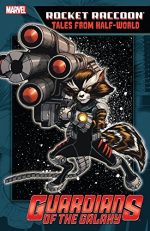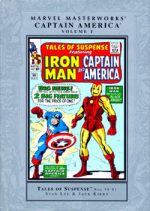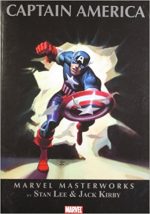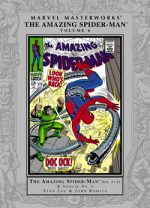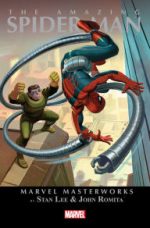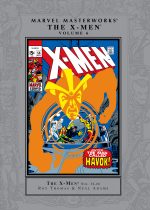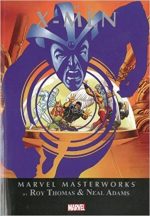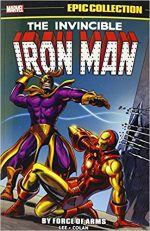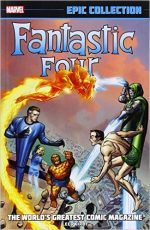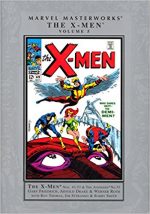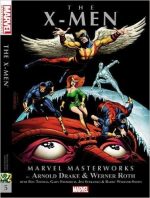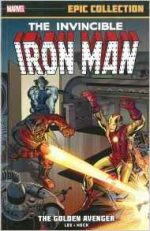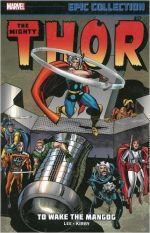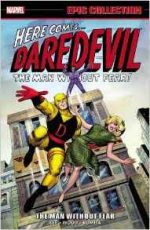
By Stan Lee, Bill Everett, Joe Orlando, Wally Wood, Bob Powell, John Romita Sr., Gene Colan & various (Marvel)
ISBN: 978-0-7851-9548-1
Matt Murdock is a blind lawyer whose remaining senses hyper-compensate, making him an astonishing acrobat, formidable fighter and living lie-detector. Very much a second-string hero for most of his early years, Daredevil was nonetheless a striking and popular one, due in large part to the roster of brilliant artists who illustrate the strip.
DD battled thugs, gangsters, a plethora of super-villains and even the occasional monster or alien invasion, quipping and wise-cracking his way through life and life-threatening combat.
As the remnants of Atlas Comics grew in popularity in the early 1960s it gradually supplanted its broad variety of genre titles with more and more super-heroes. The recovering powerhouse that was to become Marvel was still hampered by a crippling distribution deal that limited the company to 16 titles (which would curtail their output until 1968), so each new untried book would have to fill the revenue-generating slot (however small) of an existing title.
Moreover as the costumed characters were selling, each new similarly-themed title would limit the breadth of the monster, western, war, humour or girls’ comics that had been the outfit’s recent bread and butter. It was putting a lot of eggs in one basket, and superheroes had failed twice before for Marvel.
So in retrospect the visual variety of the first few issues of Daredevil, the Man Without Fear might have seemed a risky venture. Yes, the artists were all seasoned, talented veterans, but not to the young kids who were the audience. Most importantly, they just weren’t Kirby or Ditko, and new features need consistency and continuity…
Still, Lee and his rotating line-up of artists plugged on, concocting some extremely engaging tales until the latest Marvel Sensation found his feet with the hugely under-appreciated Gene Colan and the fascinating transition of moody masked avenger to wisecracking Scarlet Swashbuckler can be enjoyed in this collection gathering the first 21 issues (spanning April 1964 to October 1966) into one effervescent package of thrills and spills which begins with ‘The Origin of Daredevil’ …
This much-retold tale recounts how young Matthew Murdock grew up in the slums, raised by his father Battling Jack Murdock, a second-rate prize-fighter. Determined that the boy will be something, the father extracts a solemn promise from his son that he will never fight. Mocked by other kids who sarcastically dub him “Daredevilâ€, Matt abides by his vow, but secretly trains his body to physical perfection.
One day he saves a blind man from being hit by a speeding truck, only to be struck in the face by its radioactive cargo. His sight is burned away forever but his other senses are super-humanly enhanced and he gains a sixth, “radar-senseâ€. He tells no-one, not even his dad.
The senior Murdock is in dire straits. As his career declined he signed with The Fixer, knowing full well what the corrupt promoter expected from his fighters. Yet Jack’s star started to shine again and his downward spiral reversed itself. Unaware that he was being set up, Murdock got a shot at the Big Time, but when ordered to take a dive he refused. Winning was the proudest moment of his life. When his bullet-riddled corpse was found, the cops had suspicions but no proof…
Heartbroken Matt graduated college with a law degree and set up in business with his room-mate Franklin “Foggy†Nelson. They hired a lovely young secretary named Karen Page and, with his life on track, young Matt now had time to solve his father’s murder… His promise stopped him from fighting but what if he became “somebody elseâ€?
Scripted by Lee and moodily illustrated by the legendary Bill Everett (with assistance from Ditko) this is a rather nonsensical yet visually compelling yarn that just goes through the motions, barely hinting at the magic yet to come.
Plot-wise, the second issue fares little better as Joe Orlando & Vince Colletta take over the art: ‘The Evil Menace of Electro!’ guest-stars the Fantastic Four and features a second-hand Spider-Man villain.
The FF call in lawyer Matt Murdock just as the electrical outlaw tries to break into their building and before long Daredevil deals with Electro by the numbers. Issue #3 finally offers the sightless crusader a super-foe of his own when he meets and trounces former Wall Street financier ‘The Owl, Ominous Overlord of Crime!’
Daredevil #4 was a turning point, and just in time. ‘Killgrave, the Unbelievable Purple Man!’ finally gave some character to the big, blind stiff as he strove to overcome a villain who could exert total control over anyone who saw him. Although Orlando & Colletta’s uncomfortable, over-busy art remained for one last episode Lee finally seemed to get a handle on the hero; just in time for a magician-in-waiting to elevate the series to spectacular heights.
With #5 Wally Wood assumed the art chores where his lush, lavish work brought power, grace and beauty to the series. At last this costumed acrobat seemed to spring and dance across the rooftops and pages. Wood’s contribution to the plotting didn’t hurt either. He actually got a cover plug on his first issue.
In ‘The Mysterious Masked Matador!’ a cool, no-nonsense hero who looked commanding and could handle anything started fighting hard and fast. The series began advancing the moribund romantic sub-plot (Foggy adores Karen, who only has eyes for Matt, who loves her, but won’t let her waste her life on a blind man) and actually started making sense and progress. Most importantly, the action scenes were intoxicating…
Although a bullfighter who used his skills for crime is frankly daft, the drawing makes it utterly convincing, and the following issue’s ‘Trapped by the Fellowship of Fear!’ is a minor classic as the Man Without Fear has to defeat not only the super-powered Ox and Eel (yet more recycled villains) but his own threat-specific foe Mr. Fear who instils terror and panic in victims, courtesy of his deadly fear-gas gun.
Daredevil #7 is a true landmark: to my mind one of the Top Ten Marvel Tales of all Time. Lee & Wood concocted a true masterpiece with ‘In Mortal Combat with… Sub-Mariner!’
Prince Namor of Atlantis travels to the surface world to have his day in court and sue all Mankind, but discovers too late that his warlord, Krang, has usurped the throne in his absence. The fiery monarch cannot sit languishing in a cell when the kingdom is threatened, so he fights his way to freedom and the sea.
This cataclysmic classic shows Murdock the lawyer to be a brilliant orator, whilst the hopelessly one-sided battle with one of the strongest beings on the planet proves the dauntless courage of DD and nobility of the Sub-Mariner. Most notably, with no fanfare at all, Wood replaced the original yellow-&-black costume with the iconic and beautiful all-red outfit we know today. As one pithy commentator stated “the original costume looked as if it had been designed by a blind manâ€.
Another villain debuted in #8’s gripping industrial espionage thriller ‘The Stiltman Cometh!’ pitting the acrobat against a villain who towered above the skyscrapers after which Golden Age Great Bob Powell came aboard as penciller to Wood’s layouts and inks with #9’s ‘That He May See!’…
Relentlessly badgered by Karen, Matt finally agrees to see an eye-specialist who might be able to cure his blindness, only to become embroiled in a plot to conquer humanity by a Ruritanian maniac with a knights-in-armour fixation…
Wood was clearly chafing after a year on the book. He scripted Daredevil’s first continued story ‘While the City Sleeps!’: a political thriller which first saw Foggy run for District Attorney of New York even as mysterious mastermind The Organizer and his animal-powered gang, Bird-Man, Frog-Man, Cat-Man and Ape-Man terrorise the city.
With Powell now on full pencils and Wood just inking, Lee was left to write the concluding ‘A Time to Unmask!’ as Daredevil pulled out all the stops to confound a devious power-grab scheme which saw the villains defeated, but only at great personal cost to Nelson & Murdock…
With issue #12 Wood was gone, replaced by of an artist who was to eventually become Marvel’s top – and most loyal – star.
‘Sightless, in a Savage Land!’ was laid out by Jack Kirby and illustrated by John Romita, who had worked for Timely/Atlas in the 1950s before moving to relatively steady work on DC’s romance comics as well as freelance advertising.
He returned to take DD on an epic quest, guest-starring Tarzan-analogue Ka-Zar, that ranged from the dinosaur-haunted Savage Land via an extend battle with high-tech pirates led by The Plunderer to Jolly Olde England-land (#13’s ‘The Secret of Ka-Zar’s Origin!’) to a US Early Warning Base (#14, ‘If This be Justice…’, with what I’m sure is some un-credited assistance from George Tuska).
With this multi-part epic, Daredevil began to cement a persona as a wisecracking Scarlet Swashbuckler which would carry him all the way to the grim ‘n’ gritty Frank Miller days, far, far in the future.
Romita’s graceful, flamboyant style and expressiveness imparted new energy into the character (especially since Frank Ray Née Giacoia had been inking the series since # 14) and #15’s ‘…And Men Shall Call Him… Ox!’ showed his facility for explosive action superhero action as the dim strongman of issue #6 resurfaced, albeit in a new and sinister fashion as the lummox is made the subject of a brain-swapping experiment…
When a certain webslinger guest-starred in #16 little did anyone suspect how soon Romita would be leaving.
‘Enter… Spider-Man!’ introduced criminal mastermind, the Masked Marauder, who had big plans, the first of which was to get DD and the wallcrawler to kill each other.
With the next issue ‘None are so Blind…’ a sub-plot began that would lead to some of the highest and lowest moments of the early Daredevil after Spider-Man accuses Foggy of being the Man Without Fear!
Although the Wall-Crawler quickly realizes his mistake, others present don’t…
Issue #18’s ‘There Shall Come a Gladiator!’ introduced the manic armoured villain in a tale two-thirds scripted by legend-in-waiting Denny O’Neil, with Foggy trying to impress Karen by fostering the idea that he is Daredevil and almost perishing for the deception. Issue #19 saw the Masked Marauder ally with Gladiator in the action-packed big fight tale ‘Alone… Against the Underworld!’; a fitting farewell for Romita who was moving over to Amazing Spider-Man after Steve Ditko’s controversial departure.
Originally tipped for a fill-in issue, Gene Colan came aboard as penciller with #20’s ‘The Verdict is: Death!’, inked by Mike Esposito as Mickey DeMeo. Colan’s superbly humanistic drawing and facility with expressions was a little jarring at first since he drew Daredevil in a passable Romita imitation and everything else in his own manner, but he soon settled in and this two-part revenge thriller featuring the Owl (concluding with ‘The Trap is Sprung!’ inked by Giacoia, Dick Ayers & Bill Everett) is a fine beginning to his long, impressive run on the series, incorporating the Swashbuckler’s battle against his ferocious arch-foe, an army of thugs, deadly flying robots and even an exploding volcano to keep the readers on their toes….
Interspersed with glorious pin-ups by Wood, this bombastic full-colour compendium also offers a glimpse of original art pages by Everett and Romita & Giacoia; in-house ads; T-Shirt art and designs, layouts and sketches from Jack Kirby, Dick Ayers, Romita and Wood plus painted iterations by Dean White of Everett and Kirby art used for Marvel Masterworks covers.
Despite a few bumpy false starts Daredevil blossomed into a truly magnificent example of Marvel’s compelling formula for success: smart stories, human characters and magnificent illustration. If you’ve not read these tales before I strongly urge you to rectify that error as soon as superhumanly possible.
© 1964, 1965, 1966, 2016 Marvel Characters, Inc. All rights reserved.
